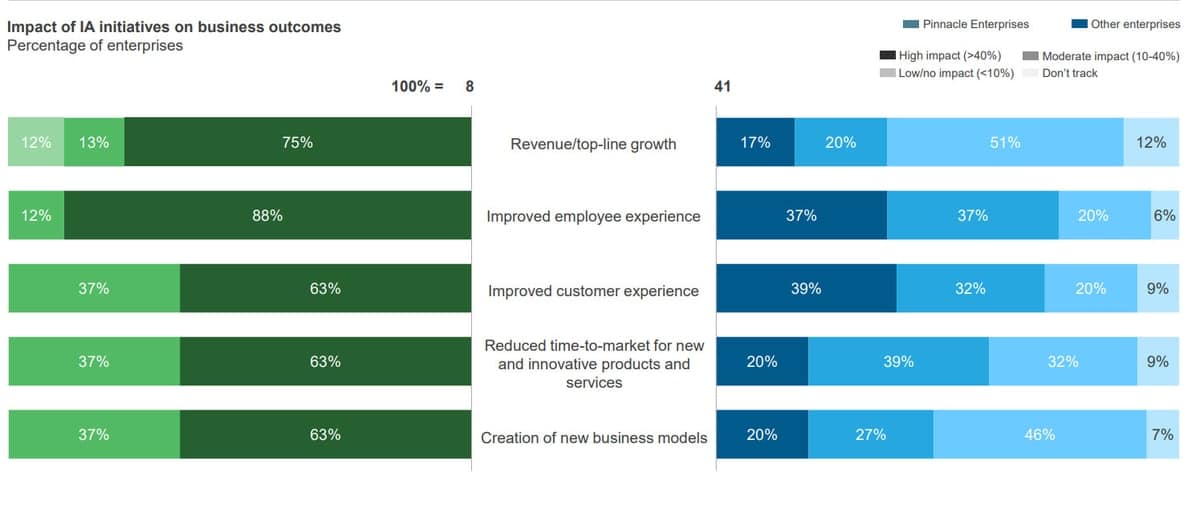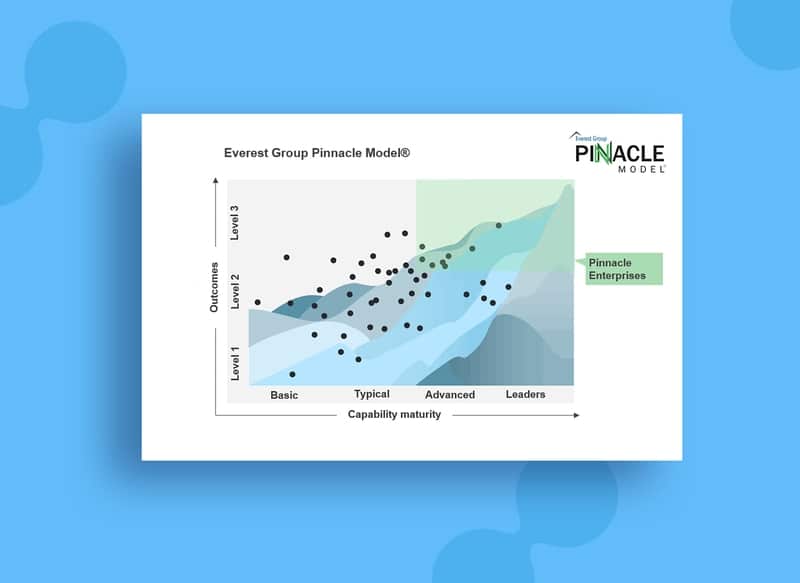Automating purely to reduce cost isn’t transformation. It’s optimization. That’s fine if you’re only interested in short-term wins, but leading enterprises — the ones who beat born-digital competitors, keep customers, and delight shareholders — are looking beyond cost reduction and envisioning long-term success.
Led by distinguished analyst Sarah Burnett, the team at Everest Research Group set out to help enterprise executives and automation practitioners understand the difference between Intelligent Automation (IA) and Robotic Process Automation (RPA). This result is this recent report: “Intelligent Automation: Accelerating from Short-term Wins to Long-term Strategic Business Outcomes: A Guide to Undertaking Automation-led Business Transformation.” A complimentary licensed copy of the report is available for download here, or read on for key points and our responses:
1. What is Intelligent Automation and how it is different from traditional RPA?
First, let’s stop thinking that Intelligent Automation is the same as RPA. There is a huge difference outlined below. Robotic process automation (RPA) follows rules to automate work that has no variation. When you log into your email account, you enter a username and password the same way every time. RPA is great for these types of repetitive tasks, which often string together to form a simple business process: log in, click a box, move a file from Point A to Point B, log out.
Scalability and ROI problems of process automation rapidly emerge, however, when a variation is introduced. How often does your business process change? How much of the high-volume work that inundates your team involves unstructured data? People adapt, but software bots that only follow rules do not.
This is why AI-driven Intelligent Automation is superior to rules-driven RPA. IA integrates all RPA capabilities plus adds capabilities to process automation only possible through bots that learn and adapt to data in real-time. According to the Everest Group report, these are some critical features of what they call “RPA 4.0” or Intelligent Automation:
- “Machine learning, computer vision, text analytics and NLP” process unstructured data, automate tasks that require judgment, and detect and adapt to constant change
- “Predictive and prescriptive analytics” help leaders plan resources and set achievable KPIs, plus help ensure optimal operational results
- “Self-managing, self-healing robots” handle exceptions and reduce bot management
In order to build a sustainable competitive advantage through business process transformation by means of Artificial Intelligence (AI), it is essential for enterprises to adopt a long-term process automation strategy that aims to implement intelligent automation solutions that combine both RPA and AI capabilities.
2. Which companies are using IA vs traditional RPA?
Everest Group takes great care to understand intelligent process automation tools, and its research team also reports on how the smartest enterprises apply them. “Pinnacle Enterprises” is a term they use to distinguish long-term strategy-focused vs. short-term, tactically-oriented businesses. (Read more here)
Pinnacle Enterprises have a wider scope of IA implementation, and they scale it up to an organization-wide level faster than other enterprises. In a comprehensive market survey, Everest Group found that among Pinnacle Enterprises:
- 63% deploy RPA with built-in AI/ML capabilities for real-time user interaction and to handle exceptions
- 75% apply machine learning capabilities in document classification, data extraction, and text analytics
- 49% develop and share libraries of reusable automation across the organization globally
3. What are the key benefits of Intelligent Automation?
Especially in banking and financial companies, regulatory compliance has eroded margins, and leaner, fast-moving digital-native competitors have more room for profit variability. Reducing cost is a critical benefit, no matter how strategic an enterprise is.
The difference between Intelligent Automation and Robotic Process Automation in terms of cost reduction is simple: IPA automates more and automates more efficiently than RPA, because IPA processes unstructured data, handles exceptions, and continuously learns. In short: Intelligent Automation delivers significantly greater cost reduction.
Siloed RPA implementations in disparate business processes can provide short-term wins for enterprises around immediate cost reduction (mostly in transactional and document processing) but may not dramatically improve business outcomes.
Thus, according to Everest Group’s Pinnacle Model analysis:
- More than half of Pinnacle Enterprises have reported over 60% cost savings
- About 50% of mentioned companies have saved more than $50 million through IA initiatives
- On average, Pinnacle Enterprises have achieved significantly higher ROI on IA initiatives than other enterprises
- More than half of businesses have been able to create more than 100 FTE work capacity using Intelligent Automation
Also: Traditional, rules-driven RPA doesn’t meaningfully reduce human effort. It just changes it. Analysts may eliminate repetitive work, but then have to spend time managing and re-training RPA bots. Intelligent Automation examples show that this technology improves employee engagement by reducing both.
Compliance is another concern in these sectors. As Everest explains in the report, “the compliance functions of enterprises from regulation-heavy verticals such as banking, insurance, and healthcare go through multi-step repetitive processes and need to navigate through complex IT architecture.” Navigating this complexity and providing the depth and detail of reporting that regulators mandate is beyond the capability of standalone RPA products. Among other intelligent process automation benefits, it’s clear that Intelligent Automation technology helps complex organizations “ensure adherence to quality and compliance.”
Again, according to Everest, Pinnacle Enterprises have achieved significantly higher operational excellence than other enterprises, especially in improving staff productivity, process accuracy, and regulatory compliance. More to that, Pinnacle Enterprises have been significantly more successful in enhancing business value by improved employee experience and top-line growth.” See the graph below.

And let’s not disregard the customer experience, the factor most responsible for driving revenue. By automating many middle- and back-office tasks connected to customer queries, companies can lower the “average handle time” (AHT), process requests with greater accuracy, and create higher customer satisfaction.
4. Why is an integrated platform superior?
Buyers of Intelligent Automation tools who understand the importance of both Artificial Intelligence and RPA to delivering superior results have two choices:
- Point solutions that require integration of RPA and AI through APIs and web services, or
- A single Intelligent Automation Platform that natively integrates all of the capabilities required to automate an end-to-end process or an entire role.
Everest thoughtfully presents the pros and cons of both approaches in the report.
Some of the benefits attributed to the first approach include “reduced single-vendor dependency” and “access to a wider partner ecosystem.” In our opinion, these both have their own downsides: more vendor management and more service checks to write.
All the cited challenges of this ecosystem approach are unambiguously negative: “increased complexity in integration,” “potentially higher TCO,” “potentially higher license costs,” and “governance & traceability challenges with multiple vendors,” among others.
On the other hand, Everest Group says the benefits of buying a single integrated Intelligent Automation Platform that provides all critical capabilities are intuitive: “ease of interoperability,” “scalability,” “reduced license cost and TCO,” “native capabilities can be optimized to work well together.” To distill it down, buying a single platform is better, cheaper, and faster.
Intelligent Automation Cloud™ provides all the capabilities required to automate across multiple functions and scale enterprise-wide with proven results while keeping the TCO under control. This all-in-one integrated platform means no gaps — and no obstacles. Feel free to contact us to see a demonstration of the platform’s capabilities.
Also published on Medium.































